Introduction
The presence of defense wounds is justly considered an important sign that an individual has been the victim of an assault. Another aspect of medicolegal significance concerns the physical activity of the victim: defense wounds indicate that the attacked person was – at least initially – conscious and able to use his limbs for protection resulting in injuries to the forearms or hands or – in rare cases – to the legs. When sustaining defense wounds, the victim must have been aware of the assault (anticipating the blow or thrust) and fit for the natural reaction of protecting himself.
Defense Wounds from Knife Attacks
Such injuries are seen when the victim attempts to ward off a knife either by seizing it or by raising forearms and hands in order to protect other body regions (head, neck, chest).
Traditionally a distinction is made in the literature between active and passive defense wounds. According to this distinction active defense wounds occur when the victim grasps the knife with the hand with the injury then being located on the palmar side of the hand. The passive wound type is sustained when the victim raises their hands or arms to protect the attacked body region; in this case the injuries will primarily be located on the extensor side.
There is only a small number of papers available with detailed statements as to the frequency and distribution of defense wounds. The frequency of such wounds indicated for victims killed by sharp force usually ranges between 30% and 50%. In victims primarily fit for reaction the probability of the presence of defense wounds increases with the number of hits placed on the body.
If in spite of multiple stabs, no defense injuries are found, it has to be considered that the victim may have been unable to react or impaired in his ability to defend himself already before the use of sharp force: for example in knife attacks on a sleeping person, in unexpected assaults and in victims made unconscious before the attack. The absence of defense wounds is also observed when the victim was held or tied. The same also largely applies in those cases where severe traumatization of a different type (e.g. by blunt force) occurred before the use of sharp force. Moreover, it is to be expected that in cases of very high blood alcohol concentrations or under the influence of drugs the ability to defend oneself adequately against an assault is reduced.
A study of large numbers of cases with regard to the localization of defense wounds found about the same number of injuries on the flexor and the extensor side, often combined in the same victim. It seems justified to express doubts as to the stereotyped distinction between active and passive defense wounds. First, the various possible ways stabbing with a knife must be taken into consideration. Different ways of moving the knife (in a downward or an upward direction) may produce defense wounds on either the extensor or flexor side for the same position of the arm. An injury on the extensor side of the limbs may also occur if the victim tries to seize the knife and the blade comes into contact with the back of the hand or the extensor side of the forearm.
In an attempt to grasp the knife the fingers of the victim may close around the blade, which cuts across the flexures of the phalanges as the knife is withdrawn (Fig. 1). In this case several fingers may be injured by a single impact of the cutting edge sometimes even completely severing the flexor tendons. Another typical location is the web between the thumb and the index finger. Incised wounds of the hands are often ‘shelved’ so that one margin forms a flap of skin (Fig. 2). Hand injuries are frequently located at the transition from the flexor to the extensor side of the fingers. Such wounds are typically encountered if the victim tries to protect himself by holding his hand against the knife with spread fingers.
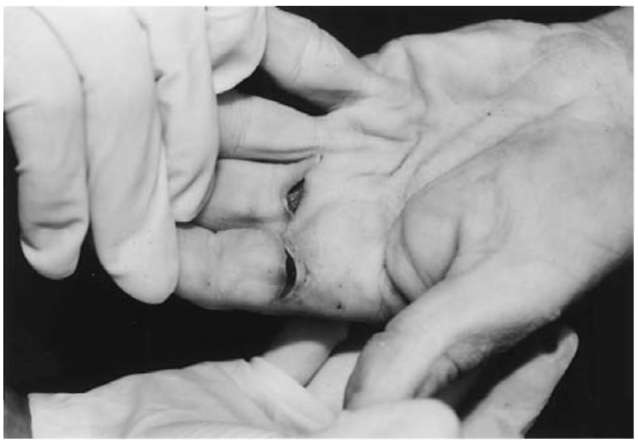
Figure 1 Two cuts on the palmar surface of the left hand caused by the cutting edge of a machete when the victim attempted to clutch the weapon.
It should be mentioned that more than two-thirds of all defense wounds are found on the left arm or left hand. To understand this phenomenon one has to visualize the position of the attacker and the victim: if somebody is in a threatening situation he will first try to bring his body into an upright position. Thus a lying person will try to stand up, a sitting person will get up. As soon as the attacker and the victim are standing opposite each other, the victim will try to ward off the assaulting hand. In doing this he will mostly rise his left arm, because it is nearest to the attacking arm of a right-handed assailant. The arm raised at the shoulder joint and flexed at the elbow is mostly hit by the assailant’s weapon on the extensor side.
In surprise attacks the described motion of the victim, which refers to the primary phase of the attack, is largely unconscious and very fast. Another reason why more injuries are located on the left-hand side may also be the unconscious attempt of the victim to maintain the function of the right arm (which is the ‘stronger’ arm in most persons) and thus to ward off the assailant with the often weaker left arm. In this connection it is of course important, whether the assailant and the victim are right- or left-handed. In rare cases defense wounds are localized even on the legs; if the victim was in a lying position he may have used his legs to ward off the knife or curled up in order to protect vital areas with his drawn up extremities.
Stabbing actions do not necessarily result in actual stab wounds but also in cuts if the blade contacts the curved surface of a limb tangentially (Fig. 3). In transfixion stab wounds the weapon passes through the soft tissues of an extremity and afterwards possibly re-enters another body region (Fig. 4).
In most cases there is considerable relative movement between the assailant and the victim. According to the dynamics of such knife attacks, an irregular wound configuration is often found. When the knife has been plunged into the body, twisting of the blade before withdrawal or turning of the victim causes wounds shaped like the letters L, Y or V (Fig. 5).
In cuts and stab wounds, shelving is likely if the blade enters at an oblique angle so that one margin is beveled and the other one undermined. Stab wounds associated with an imprint abrasion (‘hilt mark’) indicate that the blade was vigorously pushed in up to its end; a patterned abrasion possibly corresponds to the respective construction parts of the knife (e.g. handle or guard). In victims of knife attacks, incised stab wounds due to the combined action of cutting and stabbing elements are a frequent finding (Fig. 6). The wound may start as a cut which terminates as a stab wound; on the other hand some stab wounds turn into an incised wound as the knife is withdrawn at a shallow angle.
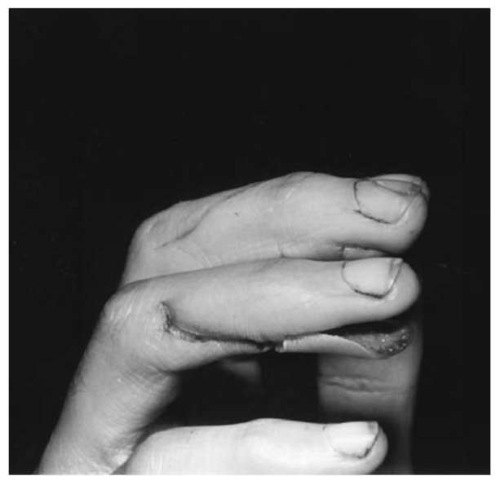
Figure 2 Defense wound of the right ring finger with beveled margin forming a skin flap.
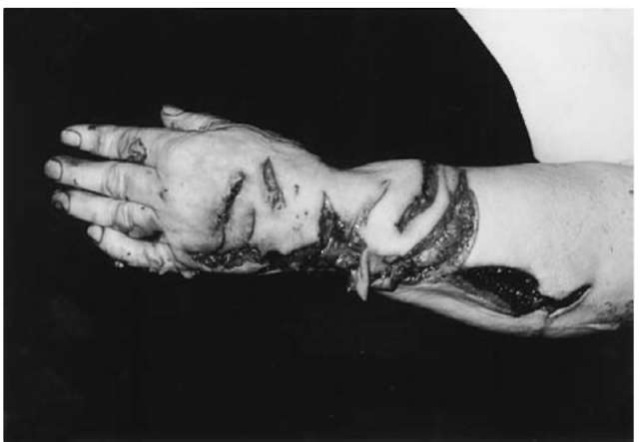
Figure 3 Multiple cuts of the left forearm and hand sustained when trying to ward off a knife attack against the neck.
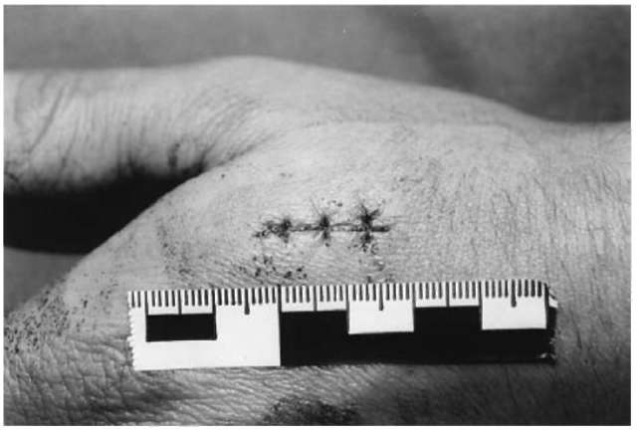
Figure 4 Transfixion stab wound of the left hand after surgical treatment. The victim tried to fend off an attack with a kitchen knife.
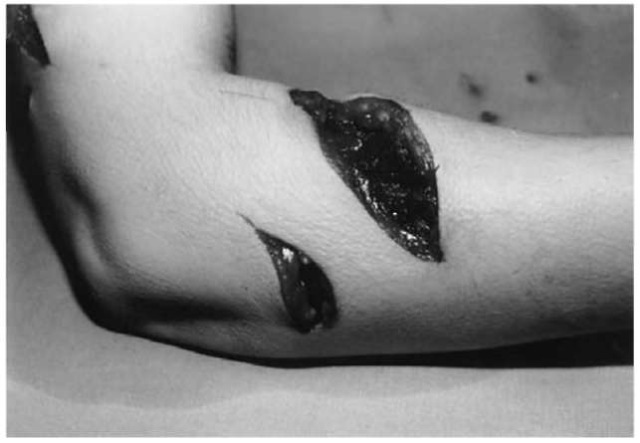
Figure 6 Defense injuries on the forearm of a victim who was killed by stab wounds to the chest and cut-throat wounds.
Defense injuries to limbs covered by garments are usually accompanied by corresponding damages/cuts in the clothing, whereas a large majority of the suicides bare the target regions before cutting or stabbing.
Defense Wounds Due to Blunt Force
Defense wounds of this kind are seen in blunt force attacks when the victim attempts to ward off kicks, blows of the fist, or blunt instruments. Their location is similar to defense wounds from knife attacks (hands, forearms or, less frequently, the legs). Injuries inflicted to the thighs possibly result from attempts to shield the genitals against blows or kicks aimed at the lower part of the body.
The injuries most often seen are abrasions and contusions (with concomitant bruising) on the back of the hands, wrists and forearms (Fig. 7). Though abrasions and bruises are the most common defense injuries due to blunt force, additional lacerations may occur in skin regions supported by bone (for example the metacarpal region and the knuckles). Lacerations from a blunt instrument possibly contain embedded foreign material indicative of the weapon used. Defense injuries inflicted together with wounds in the regions the victim wanted to protect with his hands and arms show the same stage of healing on later inspection.
In rare cases the victim may sustain fractures of the hand bones. Another classical fracture site is the ulnar shaft, which is exposed in victims parrying a blow or kick with their raised forearm. Depending on the site of the causal impact these fractures usually occur at the transition from the proximal to the middle third or in the middle third of the ulna.

Figure 5 Irregular stab wounds on the dorsal and ulnar aspect of the right forearm: one of the stab wounds is extended by a superficial incision, the other one is V-shaped due to twisting of the blade. The weapon used by the assailant was a survival knife.
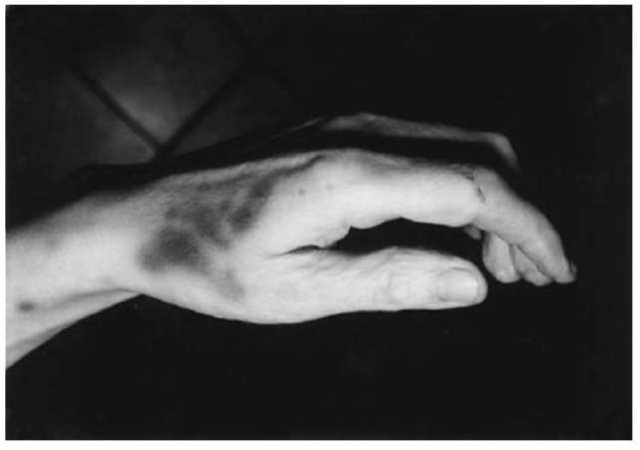
Figure 7 Bruises on the dorsal face of the left hand of a female victim who tried to protect her head against fist blows. In addition there is a shallow cut on the index finger (defense wound from a knife attack).
Defense wounds due to blunt trauma deserve special attention in suspected physical child abuse. In such cases bruises or abrasions may reflect patterned details from the instrument delivering the blow (e.g. belt, stick, rod, heel of a shoe). In adults also a great variety of blunt instruments can be used to inflict severe injuries, mainly to the head. If the hand is interposed in a protecting manner, it will primarily be hit by the weapon (Fig. 8). By placing the hands on the top of the head the victim tries to lessen the blows. Apart from typical blunt weapons as hammers, firm bottles and wrenches, sometimes also (blank cartridge) pistols and revolvers are used for striking (‘pistol whipping’).
Defense Wounds from Other Weapons
Chop wounds are a special category of injuries due to sharp force by heavy instruments with a cutting edge like axes, machetes and meat cleavers. Such wounds are characterized by cuts of the skin in combination with sharp-edged notches or comminuted fractures of the underlying bone. In attempts to ward off an assault with a chopping weapon, the back of the hand sustains deep chop wounds. Finally some uncommon stabbing instruments have to be mentioned: icepicks, forks, files, pens, scissors, screwdrivers, broken bottles.
In a wider sense even in firearm injuries the upper limbs may reveal a special kind of defense wound when the victim raises an arm in an unsuccessful attempt to shield vital areas of the body. Under such circumstances the bullet first passes through the hand or the arm and afterwards often enters the head or the thorax producing a re-entry wound (Fig. 9).
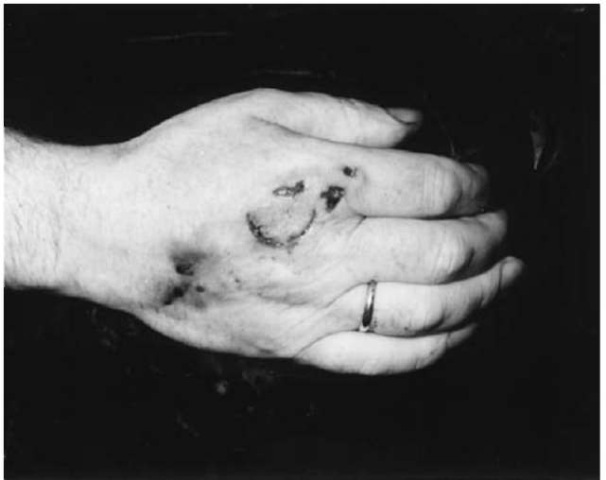
Figure 8 Defense injuries on the back of the right hand: excoriations, bruises and a shallow laceration due to multiple blows with a pistol grip.
Misleading Findings Similar to Defense Wounds
Superficial cuts restricted to the skin are sometimes found on the fingers of suicides who used double-edged razor blades for cutting their wrists. Most of these cuts do not pass through all layers of the skin so that differentiation from real defense wounds should not be difficult.
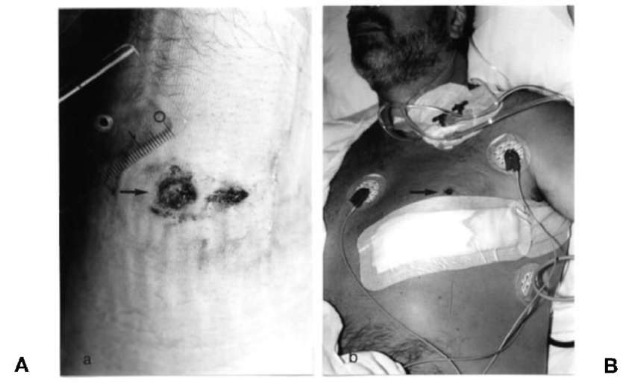
Figure 9 Entrance and exit wound of a caliber 0.32 bullet which first passed through the right forearm (A) and afterwards entered the chest (B). The victim had raised his arm when a burglar shot at him.
If a perpetrator stabs his victim using a knife without a guard, his bloody hand may slip from the handle onto the blade producing cuts on the palm or the fingers, which at first sight give the impression of real defense wounds. As a consequence, blood stains of both the victim and the assailant might be detected on the blade.
Heavy blows with the fist sometimes result in injuries to the assailant’s hand, for instance bruises or wounds from the victim’s incisors or even fractures of the metacarpal bones.
The features of self-inflicted injuries are dealt with in a separate article. Hands and arms may bear multiple incisions from a preliminary suicide attempt, mostly localized across the front of the wrists and on the flexor surface of the forearms. The typical appearance is characterized by multiple clustered wounds, mainly in a horizontal and parallel arrangement, some being very superficial tentative incisions (‘hesitation cuts’).
Apart from persons with a real suicidal tendency, numerous incisions are also seen among patients suffering from psychiatric disorders and in persons who want to draw attention to themselves (‘sympathy cuts’) particularly by making a false accusation of assault.
